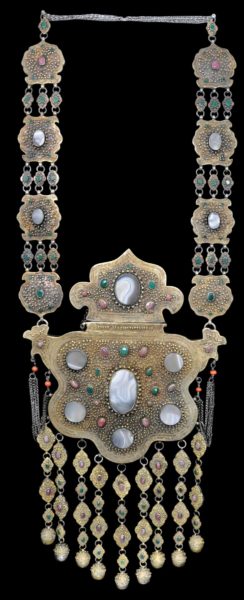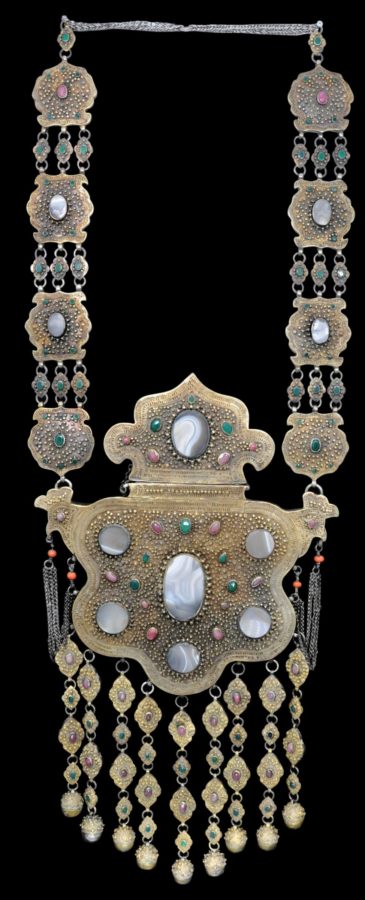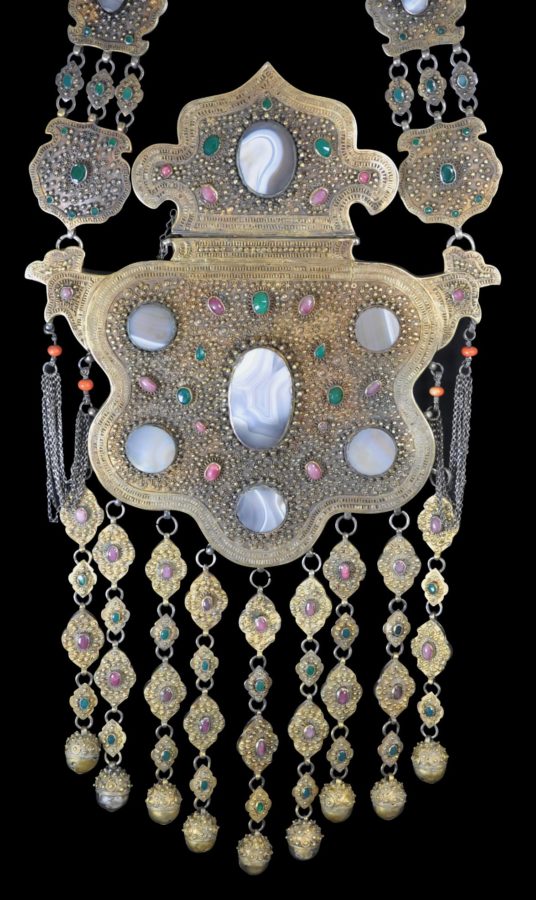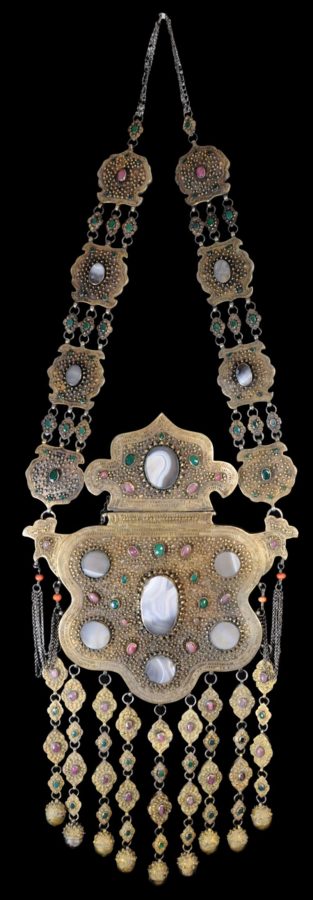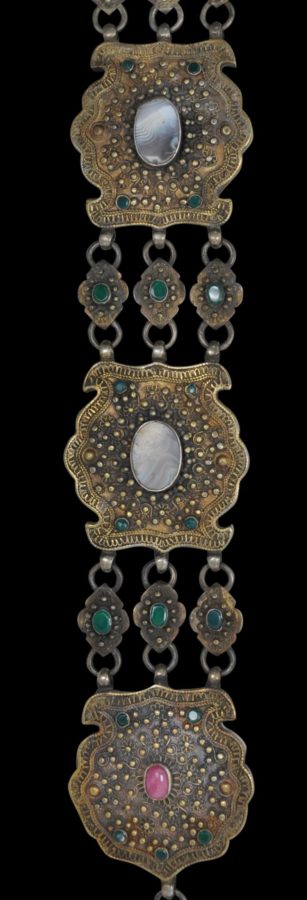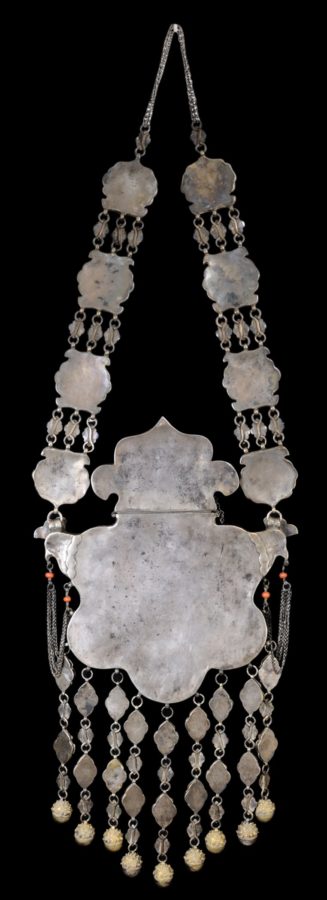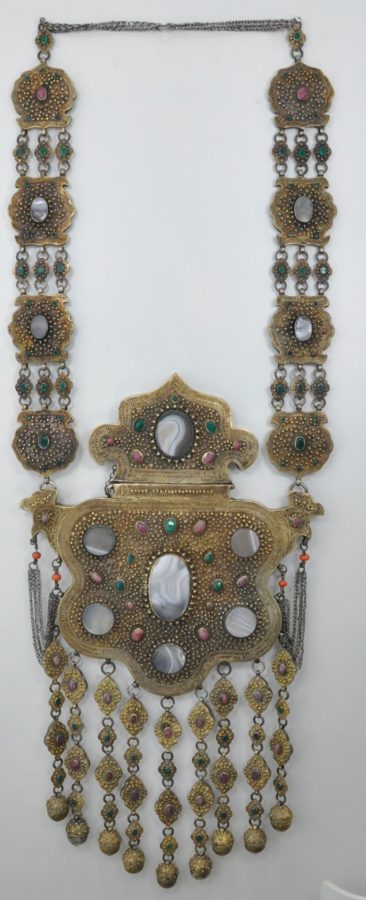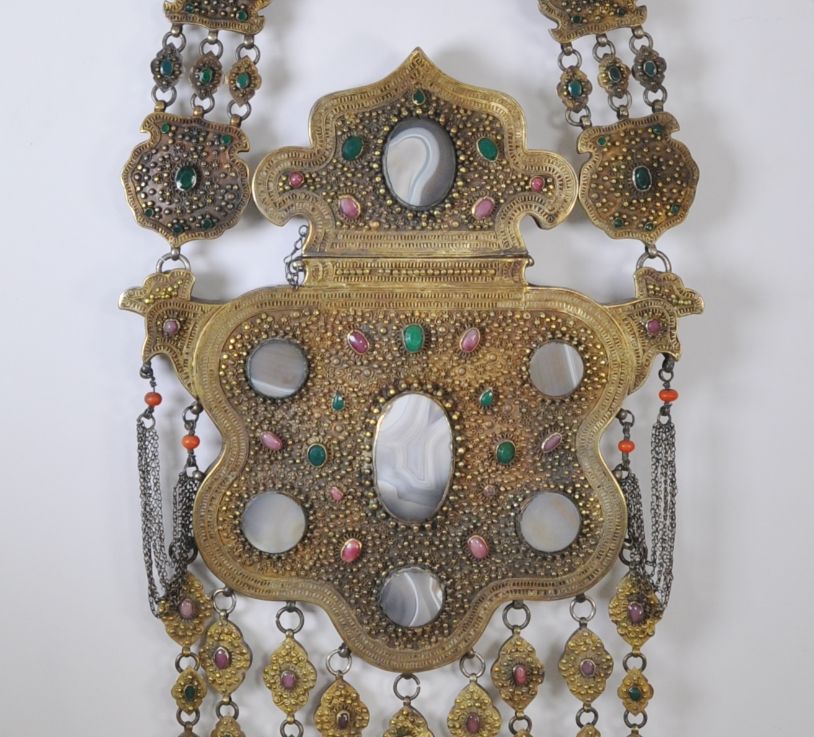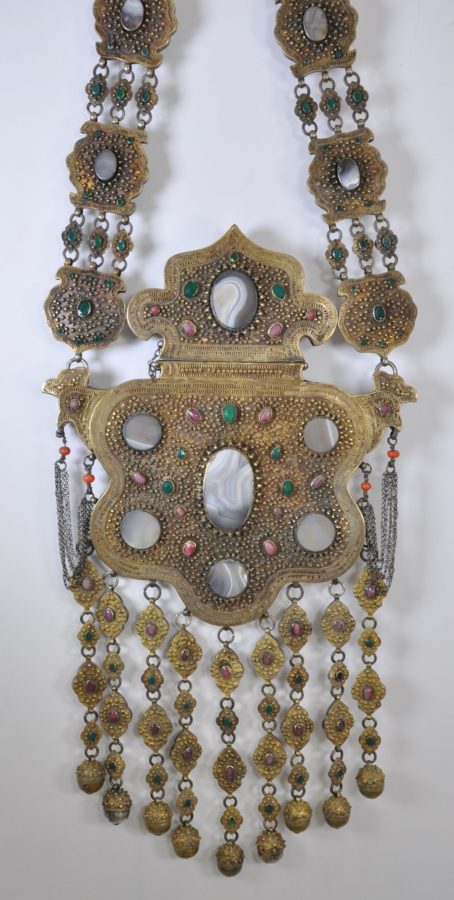This massive and exceptional amulet case and chains is from Bukhara in Central Asia. It is of gold-covered silver that has been set with banded agate, spinels, coral and green stones (105 stones altogether) and applied gilded silver filigree and other applique work.
It has a hollow body with a hinged cover.
The case is suspended from chains with four main gilded silver spacers on each side (eight in total) each of which has been set with a central slice of banded agate, a spinel or a green stone, and these are surrounded by variously four or five small green stones, all in gilded silver box settings. Three smaller spacers, each set with a green stone separate each of the main spacers.
Smaller silver chains hang from each side of the amulet case and these are decorated with coral beads.
It was intended to hold Koranic verses and other items with amulet-like properties. Sometimes such massive ornaments are described as being for a horse perhaps on the occasion of a wedding procession, but it whilst these amulets are large usually the chains are not large enough to reach around a horse’s neck for example. It seems more likely that such ornaments were worn by women from wealthy families most probably at weddings as a particularly ostentatious display of wealthy. The wearer would not have been able to move freely – the ornament is too heavy. But so often that was the point of such ostentation: the families were so wealthy that the womenfolk didn’t need to move and certainly did not need to do chores. Accordingly, the amulet appears based on a type of pectoral jewellery with a large central disc known as a gulyaka worn by Turkman women. When not in use, such an amulet might have hung on a wall inside the home as a protective device.
The crest-like top of the amulet box is hinged on one side and lifts up to allow access to the interior. It is kept closed by means of a silver pin attached to a silver chain. The box itself is in the form of two highly stylised crested birds and is decorated with copious filigree work, applied bosses and set with large slices of banded agate and other hardstones
Nine chains of suspended pendant plaques hang from the ornament. Each is of gilded silver set with numerous filigree bosses and and alternating spinel and green stone stones. Each chain terminates with a large, gilded, acorn-like pendant.
Almost certainly the amulet case came from the holdings of the Emir of Bukhara or a similarly aristocratic family. The Emir’s family and other aristocratic families lost their assets in 1920 when the Emirate was overrun by Russia’s Red Army and the position of Emir was abolished.
The Emirate of Bukhara was a Central Asian state that existed between 1785 and 1920. It occupied a region formerly known as Transoxiana.
The ancient trading outposts of Samarkand and the emirate’s capital, Bukhara, were the principal cities and it bordered the Khanates of Khiva and Kokand. It is now within the boundaries of Uzbekistan.
The Emirate was founded in 1785 by the the Manghit emir, Shah Murad. The Emirate lost a war with Imperial Russia in 1868 and Russia annexed most of the Emirate’s territory. The Emirate became a Russian protectorate in 1873. The position of the Emir remained of which Abd al-Ahad (Emir 1885-1910) was particularly notable. (This amulet most probably dates from his rule.) The conservative Emir Mohammed Alim Khan was removed in 1920 when the Emirate was over-run by the Red Army and the Bukharan People’s Soviet Republic was established.
A large amulet of similar form and almost identical size but decorated with enamel work rather than filigree is in the collection of Kuwait’s Tareq Rajab Museum. The Kuwait piece is provenanced to the ‘last emirs of Bukhara’ (Tareq Rajab Museum, 1994, p. 76.) Almost all other known similar large amulet boxes were acquired by a single American collector around this time. Several similar amulets, from the same collection, were included in Christie’s New York, ‘Indian and Southeast Asian Art’, March 31, 2005. Another, sold by us, is now in Singapore’s Asian Civilisations Museum. Another, though less elaborate example, is in the Khalili Collection (see Alexander, 1992, p. 156),
Overall, this is a rare, visually stunning, and extraordinary item from the Islamic world. It is in excellent condition, contains a great deal of silver, and is ideal for display mounted against a wall. It is of museum quality, and indeed, most of those few other examples of this type do now appear to be in museums.
References
Alexander, D., The Arts of War: Arms and Armour of the 7th to 19th centuries – The Nasser. D. Khalili Collection of Islamic Art, The Nour Foundation, 1992.
Mansel, P., Sultans in Splendour: Monarchs of the Middle East 1869-1945, Parkway Publishing, 1988.
Tareq Rajab Museum, Tareq Rajab Museum, Kuwait, 1994.
Christie’s New York, ‘Indian and Southeast Asian Art’, March 31, 2005, lots 213-217.


